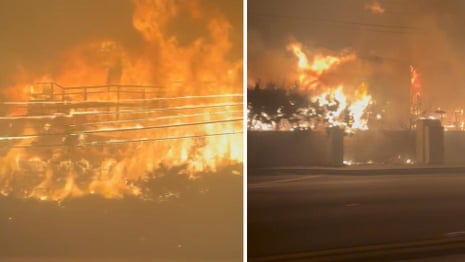Fast-moving wildfires tore through several neighborhoods of Los Angeles, killing at least two people and incinerating more than 1,000 buildings in the western megalopolis.
The disaster began on Tuesday afternoon, when a powerful windstorm fanned the flames of a fire in the scenic Pacific Palisades neighborhood, quickly forcing thousands to flee.
The emergency intensified overnight as firefighters struggled to contain the flames in the intense winds during what one official described as among the “most devastating and terrifying nights” in city history.
By morning, authorities had dispatched firefighters from across California to aid in tackling at least four blazes besieging the region.
Officials have said they are “prioritizing life over everything else” in their response.
More than 70,000 people have been ordered to evacuate their homes and more than 13,000 buildings from the affluent neighborhoods on the city’s west side overlooking the Pacific Ocean to the hillside suburbs in the east are under threat. Officials say the flames have left a number of people with significant injuries.
Efforts to contain the fires are being hindered by a “life-threatening” windstorm affecting a large swath of southern California.
The LA county fire chief, Anthony Marrone, said on Wednesday morning there were not enough fire personnel to handle the fires. “There are not enough firefighters in LA county to address four separate fires of this magnitude,” Marrone said. The county was prepared for “one or two brushfires, but not four, especially given these sustained winds and low humidities”, he said.
In some parts of LA, the evacuation effort had been frenzied, as residents rushed to the few roads leading out of communities. The flames moved so quickly in some areas that residents were forced to abandon their cars and flee on foot, later leading to jammed roads that first responders had to clear in order to get through. In the Pacific Palisades, Sheriece Wallace said she unaware there was a fire burning around her until her sister called at the moment a helicopter made a water drop overhead.
“I was like, ‘It’s raining,’” Wallace said. “She’s like, ‘No, it’s not raining. Your neighborhood is on fire. You need to get out.’”
“As soon as I opened my door, it was like right there,” she said. “The first thing I did was looked at the trees to see where the wind was blowing. Because it hit me. It blew me back.” She was able to leave.
The extent of the damage in the Pacific Palisades was unclear by Wendesday morning, and the fire remained wholly uncontained.
More than 1,000 structures have been destroyed because of the Palisades fire and about 37,000 residents are under evacuation orders. While no fatalities have been reported for this fire, there have been a “high number of significant injuries to residents who did not evacuate”, Marrone said.
Other inland wildfires in the Los Angeles vicinity were also spreading fast, including a major fire in Altadena, near Pasadena, which officials have called the Eaton fire. That blaze was almost as large as the Palisades fire, with more than 2,200 acres of burned land.
Marrone said the Eaton fire continued to grow and there had been two reported fatalities and a number of “significant” injuries. More than 100 structures have been destroyed, he said.
Two smaller fires were also reported by fire services, including the Hurst fire, in Sylmar, in the San Fernando Valley, north-west of Los Angeles, and one that began on Wednesday named the Woodley fire, near the Van Nuys neighbourhood.
All four fires were 0% contained, according to officials from California’s department of forestry and fire protection. A fifth fire to the east of the city, named the Tyler fire, began overnight but was largely contained.
The governor of California, Gavin Newsom, has declared a state of emergency. Before daybreak on Wednesday morning, he released a statement saying the state had deployed more than 1,400 firefighting personnel “to combat these unprecedented fires in LA”.
Meanwhile, residents in the sprawling suburbs and rural enclaves are bracing for another day of brutal wind. Gusts across the southern California region peaked at 100mph, with swaths of the area seeing between 50-80mph winds over the last two days.
Trees thrashed and debris was strewn across yards in Chatsworth, California, a neighborhood at the foot of the Santa Susana mountains, throughout a sleepless night on Tuesday. Residents anxiously kept watch on the glowing horizons and billowing smoke pluming over the mountains above wondering if new ignitions would start in the night.
Wind-whipped fires are difficult to stop and can move incredibly fast, especially through these parched landscapes.
“It was very surreal,” said Patty Robinson, a resident, after trees thumped against her roof and the gusts howled. “To hear this wind and know the effect it is having and the damage that it can bring makes my hackles rise,” she added. “My little lizard brain is freaking out.”
The National Weather Service (NWS) had previously issued its highest alert for extreme fire conditions for much of Los Angeles county until Thursday. Low humidity and dry vegetation due to a lack of rain meant the conditions were “about as bad as it gets in terms of fire weather”, the NWS said.
In a Wednesday update, the service warned the most extreme conditions were expected on Wednesday morning.
Gusts could reach speeds of 100mph (160km/h), the NWS said. The powerful winds have grounded Air Force One in Los Angeles, forcing a change in the travel plans of the president, Joe Biden.
Human-caused climate breakdown is supercharging extreme weather across the world, driving more frequent and more deadly disasters from heatwaves to floods to wildfires.
The region has been experiencing warmer than average temperatures in January, in part due to recent blasts of dry air, including the notorious Santa Ana winds. Southern California has not recorded more than 0.1in (2.5mm) of rain since early May.
Jeff Monford, a power utility spokesperson, said it was not always possible to give advanced notice to customers of power shutoffs, telling the Los Angeles Times: “This is a phenomenon of the increasing effects of climate change on weather. We have more weather extremes that can change more quickly than we might be accustomed to.”
More than 400,000 homes and businesses in Los Angeles county were without power on Wednesday, data from PowerOutage.us showed.
Videos shared by people online showed flames licking homes through the canyons, thrashing trees blowing in the wind and plumes of black smoke billowing into the sky.
As the fire rapidly spread, severe gridlock on narrow streets led many to leave their cars, some of which were subsequently engulfed in flames. With ditched vehicles blocking first responders, authorities were forced to use bulldozers to them.
In Altadena, the flames from the Eaton fire spread so rapidly that staff at a senior living centre had to push residents in wheelchairs and hospital beds down the street to a parking lot, the Associated Press reported.
The residents waited there in their bedclothes as embers fell around them until ambulances and buses arrived to take them to safety. One was a as old as 102, the agency reported.
Evacuees described harrowing escapes, including one woman who recounted to ABC7 how she abandoned her vehicle and fled with her cat in her arms. She said: “I’m getting hit with palm leaves on fire … It’s terrifying. It feels like a horror movie. I’m screaming and crying walking down the street.”
The blazes also reached the grounds of the Getty Villa, an art museum by the Malibu coast. Some vegetation on the property burned, but museum officials said no structures had been affected and that the galleries and staff were protected by a range of prevention measures.
The Associated Press and Reuters contributed reporting

